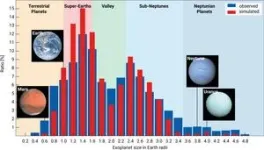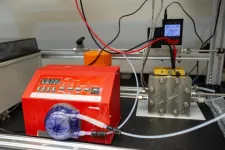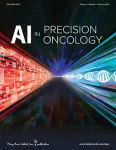Towards A Better Way of Releasing Hydrogen Stored in Hydrogen Boride Sheets
2024-02-09
(Press-News.org)
The looming threat of climate change has motivated scientists worldwide to look for cleaner alternatives to fossil fuels, and many believe hydrogen is our best bet. As an environmentally friendly energy resource, hydrogen (H2) can be used in vehicles and electric power plants without releasing carbon dioxide into the atmosphere.
However, storing and transporting H2 safely and efficiently remains a challenge. Compressed gaseous hydrogen poses a significant risk of explosion and leakage, whereas liquid hydrogen must be maintained at extremely low temperatures, which is costly. But what if we could store hydrogen directly in the molecular composition of other liquid or solid materials?
This was the focus of a team of scientists from Japan, who, in a recent study published in the journal Small, investigated the potential of hydrogen boride (HB) sheets as practical hydrogen carriers. Storing hydrogen in HB sheets is not an entirely new concept, and many aspects of their potential applications as hydrogen carriers have already been studied. However, getting the hydrogen out of the sheets is the tricky part. Heating at high temperatures or strong ultraviolet (UV) illumination is required to release hydrogen (H2) from HB sheets. However, both approaches have inherent disadvantages, such as high energy consumption or incomplete H2 release.
Thus, the team delved into a potential alternative: electrochemical release. Based on the mechanism of UV-induced H2 release from HB sheets, the team speculated that electron injection from a cathode electrode into HB nanosheets by an electric power supply could be a superior way to release H2 compared to UV irradiation or heating.
Based on this theory, the researchers dispersed HB sheets into acetonitrile—an organic solvent—and applied a controlled voltage to the dispersion. These experiments revealed that nearly all of the electrons injected into the electrochemical system were used to convert H+ ions from the HB sheets into H2 molecules. Notably, the Faradaic efficiency of this process, which measures how much electrical energy is converted into chemical energy, was over 90%.
The team also conducted isotope tracing experiments to confirm that the electrochemically released H2 originated from the HB sheets and not through some other chemical reaction. Moreover, they also employed scanning electron microscopy and X-ray photoelectron spectroscopy to characterize the sheets before and after H2 release, yielding further insights into the underlying mechanisms of the process.
These findings contribute to the development of safe and lightweight hydrogen carriers with low energy consumption. Although the team studied the dispersed form of the HB sheets in the published paper, the current findings are applicable to film or bulk-based HB sheet systems for H2 release. Moreover, the team will investigate the rechargeability of HB sheets after dehydrogenation in a future study.
With any luck, this line of research will help pave the way to cleaner energy sources and more sustainable societies!
END
ELSE PRESS RELEASES FROM THIS DATE:
2024-02-09
Immigrants living with dementia were more likely to present with agitation and aggression compared with their non-immigrant counterparts, a new study by Edith Cowan University (ECU) in collaboration with The Dementia Centre, HammondCare, found.
Researchers from ECU’s Centre for Research in Aged Care and HammondCare’s The Dementia Centre noted that behaviours and psychological symptoms of dementia (BPSD), such as agitation and aggression, are common; however, its presentation may be influenced by the cultural background of the person.
A study investigated differences in clinical and demographics characteristics ...
2024-02-09
Engineers at the University of Cincinnati created a more efficient way of converting carbon dioxide into valuable products while simultaneously addressing climate change.
In his chemical engineering lab in UC’s College of Engineering and Applied Science, Associate Professor Jingjie Wu and his team found that a modified copper catalyst improves the electrochemical conversion of carbon dioxide into ethylene, the key ingredient in plastic and a myriad of other uses.
Ethylene has been called ...
2024-02-09
The onset of psychosis can be predicted before it occurs, using a machine-learning tool which can classify MRI brain scans into those who are healthy and those at risk of a psychotic episode. An international consortium including researchers from the University of Tokyo, used the classifier to compare scans from over 2,000 people from 21 global locations. About half of the participants had been identified as being clinically at high risk of developing psychosis. Using training data, the classifier was 85% accurate at differentiating between people ...
2024-02-09
Students’ knowledge and perceptions of active learning declined significantly during COVID-induced remote teaching and have not recovered to pre-pandemic levels, according to new research from Chapman University Assistant Professor Jeremy Hsu.
Hsu says the benefits of active learning – exercises like group projects, problem-solving and class discussions – are well documented, but he emphasizes that students’ understanding and perceptions of the practice can affect their level of engagement and investment. If students have limited exposure or are hesitant to participate in active learning practices, resistance could ...
2024-02-09
A new study evaluates an artificial intelligence (AI)-based algorithm for autocontouring prior to radiotherapy in head and neck cancer. Manual contouring to pinpoint the area of treatment requires significant time, and an AI algorithm to enable autocontouring has been introduced. The study is published in the peer-reviewed journal AI in Precision Oncology. Click here to read the article now.
Nikhil Thaker, from Capital Health and Bayta Systems, and coauthors, evaluated the performance of various LLMs, including OpenAI’s GPT-3.5-turbo, GPT-4, GPT-4-turbo, ...
2024-02-09
ALBUQUERQUE, N.M. — One of Sandia National Laboratories’ core missions is to help the world through innovation.
However, transferring some of that innovation from the Labs to industry isn’t always an easy process.
Through hard work and ingenuity, some Sandia employees are excelling at moving technology to market, a feat that is now being honored by the Federal Laboratory Consortium. The consortium, composed of more than 300 members nationwide, provides a forum to develop strategies and opportunities for linking laboratory technologies and expertise in the marketplace.
Regional Technology Transfer Award: Disinfectant ...
2024-02-09
A new study evaluates an artificial intelligence (AI)-based algorithm for autocontouring prior to radiotherapy in head and neck cancer. Manual contouring to pinpoint the area of treatment requires significant time, and an AI algorithm to enable autocontouring has been introduced. The study is published in the peer-reviewed journal AI in Precision Oncology. Click here to read the article now.
Sushil Beriwal, from Allegheny Health Network, and Varian, and coauthors, analyzed 108 patients ...
2024-02-09
Analysis of racial disparities in US homicide rates indicates Black women were on average six times more likely to die by homicide than White women between 1999 and 2020.
Homicide rates among Black women were significantly higher than for White women in all 30 states analysed, with some evidence suggesting the biggest differences are in states with the highest racial inequities.
The greatest disparity in homicide rates was in Wisconsin in 2019-2020, when Black women were 20 times more likely to be ...
2024-02-09
A research paper published today (8 February 2024) in The Lancet Oncology demonstrates that the drug enobosarm, a selective androgen receptor modulator which stimulates the male sex hormone receptor has anti-tumour effects in oestrogen receptor positive breast cancer patients.
Lead author Professor Carlo Palmieri from the University of Liverpool and The Clatterbridge Cancer Centre NHS Foundation Trust, said: “These results are very encouraging – we have shown that in advanced/metastatic breast cancer ...
2024-02-09
A single test to speed up diagnosis of a serious disease in pregnant women does not need to be repeated, new research has found.
Results from the PARROT-2 trial, published today in the Lancet by researchers from King’s College London and funded by Jon Moulton Charitable Trust, Tommy’s Charity and the National Institute for Health and Care Research, has ruled out the need for routine repeat placental growth factor-based testing (PIGF) for all women with suspected pre-eclampsia.
PARROT-2 is a large, multi-centre UK trial in 1,252 women ...
LAST 30 PRESS RELEASES:
[Press-News.org] Towards A Better Way of Releasing Hydrogen Stored in Hydrogen Boride Sheets







